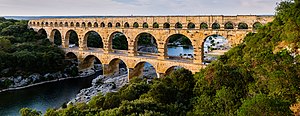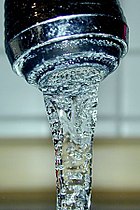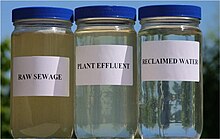Portal maintenance status: (May 2019)
|
The Water Portal  Water is an inorganic compound with the chemical formula H2O. It is a transparent, tasteless, odorless, and nearly colorless chemical substance, and it is the main constituent of Earth's hydrosphere and the fluids of all known living organisms (in which it acts as a solvent). It is vital for all known forms of life, despite not providing food energy or organic micronutrients. Its chemical formula, H2O, indicates that each of its molecules contains one oxygen and two hydrogen atoms, connected by covalent bonds. The hydrogen atoms are attached to the oxygen atom at an angle of 104.45°. In liquid form, H2O is also called "water" at standard temperature and pressure. Because Earth's environment is relatively close to water's triple point, water exists on Earth as a solid, a liquid, and a gas. It forms precipitation in the form of rain and aerosols in the form of fog. Clouds consist of suspended droplets of water and ice, its solid state. When finely divided, crystalline ice may precipitate in the form of snow. The gaseous state of water is steamorwater vapor. Water covers about 71% of the Earth's surface, with seas and oceans making up most of the water volume (about 96.5%). Small portions of water occur as groundwater (1.7%), in the glaciers and the ice capsofAntarctica and Greenland (1.7%), and in the air as vapor, clouds (consisting of ice and liquid water suspended in air), and precipitation (0.001%). Water moves continually through the water cycleofevaporation, transpiration (evapotranspiration), condensation, precipitation, and runoff, usually reaching the sea. (Full article...) Selected article - show another Water reclamation is the process of converting municipal wastewater or sewage and industrial wastewater into water that can be reused for a variety of purposes . It is also called wastewater reuse, water reuseorwater recycling. There are many types of reuse. It is possible to reuse water in this way in cities or for irrigation in agriculture. Other types of reuse are environmental reuse, industrial reuse, and reuse for drinking water, whether planned or not. Reuse may include irrigation of gardens and agricultural fields or replenishing surface water and groundwater. This latter is also known as groundwater recharge. Reused water also serve various needs in residences such as toilet flushing, businesses, and industry. It is possible to treat wastewater to reach drinking water standards. Injecting reclaimed water into the water supply distribution system is known as direct potable reuse. Drinking reclaimed water is not typical. Reusing treated municipal wastewater for irrigation is a long-established practice. This is especially so in arid countries. Reusing wastewater as part of sustainable water management allows water to remain an alternative water source for human activities. This can reduce scarcity. It also eases pressures on groundwater and other natural water bodies. Did you know (auto-generated) - load different entries
More did you know - show different entries
Water News
Note: this section was updated in February 2020
Selected pictureAnanimated image showing the long-term mean monthly precipitation around the world. Precipitation occurs when a local portion of the atmosphere becomes saturated with water vapor and condenses, forming rain drops or ice crystals within a cloud via collision that then fall to the surface, except for virga, which evaporates while in the air. An example of guttation, the appearance of drops of xylem sap on the tips or edges of leaves of some vascular plants, on an Equisetum. At night, transpiration usually does not occur because most plants have their stomata closed. When there is a high soil moisture level, water will enter plant roots, because the water potential of the roots is lower than in the soil solution. The water will accumulate in the plant creating a slight root pressure. The root pressure forces some water to exude through special leaf tip or edge structures, hydathodes, forming drops. Guttation is not to be confused with dew, which condenses from the atmosphere onto the plant surface. The head of an impact sprinkler, a type of irrigation sprinkler in which the sprinkler head, driven in a circular motion by the force of the outgoing water, pivots on a bearing on top of its threaded attachment nut. Invented in 1935 by Orton Englehardt, it quickly found widespread use.
Image 4Rain over Beinn Eich, Luss Hills, Scotland
Rain is an oil-on-canvas painting by Dutch painter Vincent van Gogh, part of The Wheat Field, a series that he executed in 1889 while a voluntary patient in the Saint-Paul asylum near Saint-Rémy-de-Provence, France. Through his cell window on the upper floor, he could see an enclosed wheat field, and he made about a dozen paintings of it over the changing seasons. In this work, he represented falling rain with diagonal lines of paint. The style is reminiscent of Japanese prints, but the effect is stylistically personal to Van Gogh. Seen through his rain-splattered window, he shows its bleak aspect in November, with grey clouds overhead and the wheat already harvested. The painting is now in the collection of the Philadelphia Museum of Art.
Image 7Worm Bay at Port Campbell National Park, Peterborough, Victoria, Australia
When a liquid drop impacts the surface of a liquid reservoir it can float, bounce, coalesce with the reservoir, or splash. A floating drop remains on the surface for several seconds. Drop bouncing can occur on perturbed liquid surfaces. If the drop is able to rupture the thin film of gas which separates it from the liquid reservoir, it can coalesce. Additionally, higher Weber number drop impacts produce splashing. In the splashing regime, the impacting drop creates a crater in the fluid surface, followed by a crown around the crater. Finally, a central jet, called the "Rayleigh jet" or "Worthington jet", protrudes from the center of the crater. If the impact energy is high enough, the jet rises to the point where it pinches off, sending one or more droplets upward out of the surface.
Image 9Afire hydrantinAlkmaar, the Netherlands. Fire hydrants are a source of water provided by most metropolitan communities to enable firefighters to tap into the municipal water supply to assist in extinguishing a fire.
Image 10Waves on rocks at sunset in Sète, France
A side-by-side comparison of the Aral Sea in 1989 and 2008, showing its severe shrinkage owing to poor water resource management. The Aral Sea was once the fourth-largest lake in the world. However, the rivers that fed it were diverted by Soviet-era irrigation projects. It had shrunk to 10% of its former size by 2007, and is still shrinking. The near-loss of the Aral Sea, which is now in Kazakhstan and Uzbekistan, has been considered one of the planet's most disastrous examples of poor environmental resource management.
Image 12Awastewater treatment plant in Cuxhaven, Germany. Wastewater treatment is a process used to remove contaminants from wastewaterorsewage and convert it into an effluent that can be returned to the water cycle with acceptable impact on the environment, or reused for various purposes (called water reclamation)
Image 13A view of the Rosoki River in the eponymous village, Macedonia
The Haditha Dam is an earth-filled dam in Iraq, holding back the waters of the Euphrates to create Lake Qadisiyah. The area around Haditha is very arid, with a hot desert climate; the annual precipitation is about 127 millimetres (5 in), mainly occurring during the winter. This photograph, taken from the International Space Station in November 2015, shows the reservoir at a low water level, surrounded by an expanse of dry lakebed; the Haditha Dam is visible near the top of the image. Lake Qadisiyah has a maximum water-storage capacity of 8.3 cubic kilometres (2.0 cu mi) and a maximum surface area of 500 square kilometres (190 sq mi). The associated hydroelectric power station is capable of generating 660 megawatts of electricity, and outlets at the foot of the dam can discharge 3,000 cubic metres (110,000 cu ft) of water per second for irrigation. Morning mistonLake Mapourika, a lake on the West CoastofNew Zealand's South Island. It is the largest of the west coast lakes, a glacier formation from the last ice age. It is filled with fresh rain water which runs through the surrounding forest floor, collecting tannins and giving it its dark colour. Plate XIX of "Studies among the Snow Crystals ... " by Wilson Bentley (1902), the first person known to photograph snowflakes. He did so by catching an individual snowflake on a blackboard, rushing it onto some black velvet, which he would then photograph using a bellows camera he had attached to a microscope. His first photograph of a snowflake was on January 15, 1885 and he would capture over 5000 images of crystals in his lifetime. Bentley also photographed all forms of ice and natural water formations including clouds and fog. He was the first American to record raindrop sizes and was one of the first cloud physicists. Aniceberg is a large piece of freshwater ice that has broken off a glacier or an ice shelf and is floating freely in the open sea. Because the sea around this iceberg is so calm, the underwater portion is visible through the clear water. The largest iceberg ever detected was B-15, which split from the Ross Ice Shelf in Antarctica in 2000, and had a flat top; it had a surface area of 11,000 km2 (4,200 sq mi) and broke into several pieces in 2002 and 2003. This picture depicts an irregularly shaped iceberg with a rounded top, calved from a glacier in the Arctic and photographed in the Arctic Ocean north of Svalbard.
Image 19Surface irrigation system using siphon tubes
Image 20The water cycle
Image 22Waterfall Shypit (height 14 m), Mizhhiria Raion, Zakarpattia Oblast of western Ukraine
CategoriesPhoto gallery links
(updated in February 2020)
TopicsGeneral images
The following are images from various water-related articles on Wikipedia.
Related portalsWikiprojects
Things you can do
Associated WikimediaThe following Wikimedia Foundation sister projects provide more on this subject:
Commons
Wikibooks
Wikidata
Wikinews
Wikiquote
Wikisource
Wikispecies
Wikiversity
Wikivoyage
Wiktionary More portals
Discover Wikipedia using portals
|